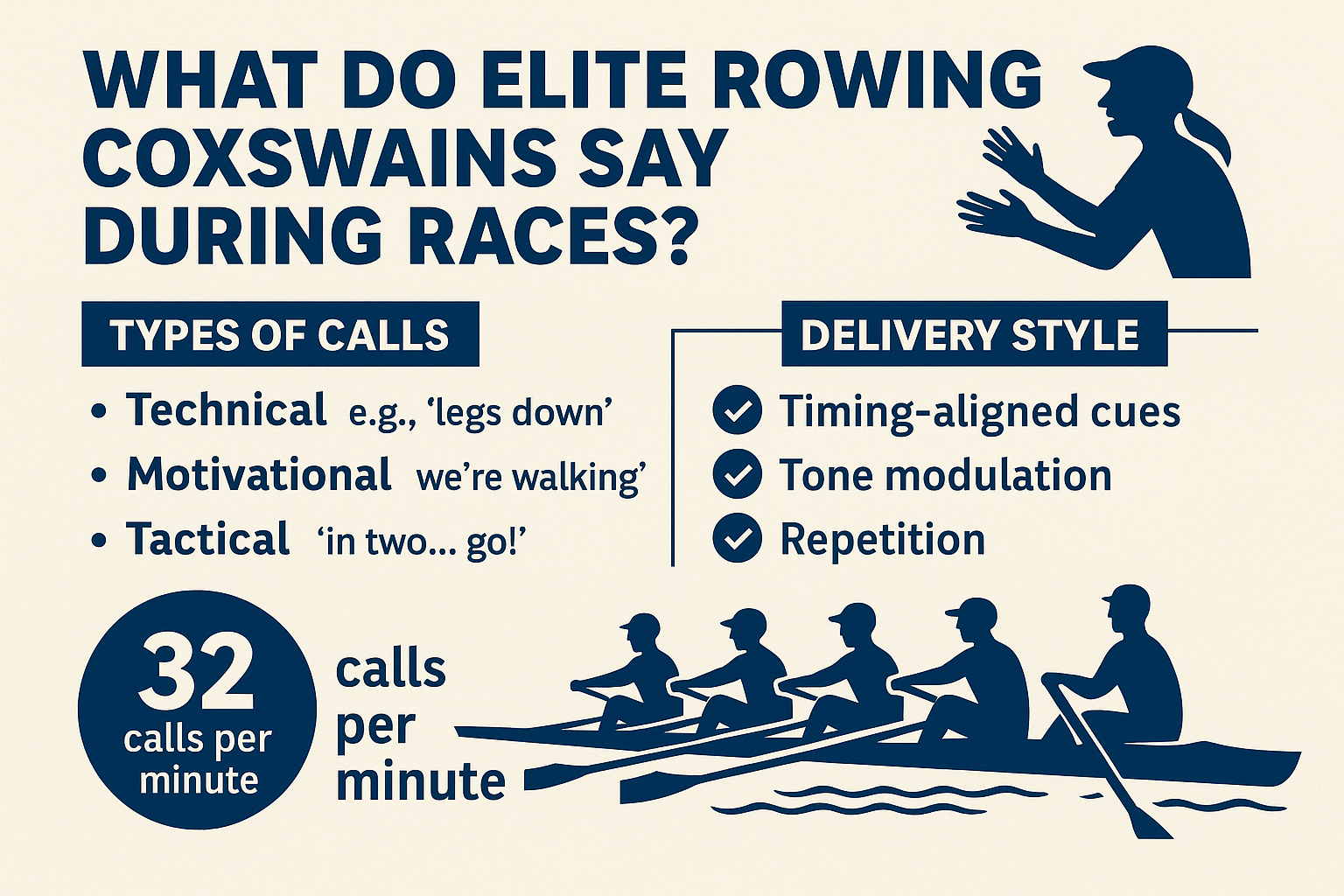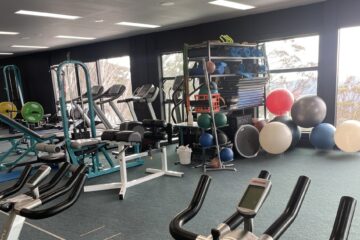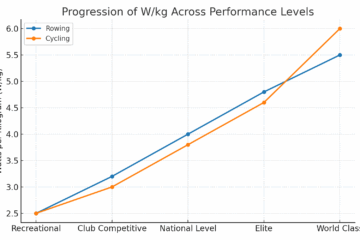It’s a bit of a “how long is a piece of string?” question. Every crew and every athlete responds differently to how they’re coxed (just as they do to coaching). But with so many of us glued to YouTube right now — or lucky enough to be over in London watching Henley live — it’s hard not to wonder: what actually makes the difference?
A recent study, “What do elite rowing coxswains say during races?” (link here), sheds some light on this. With the help of AI, I’ve summarised the key findings below.*
A few important caveats before diving in:
- The study looked specifically at elite-level coxswains, competing at the very top of the sport.
- The vast majority of us aren’t racing at that level; we’re club and masters rowers. That’s important context when thinking about how these findings might (or might not) apply.
- Also, when the article talks about “technical calls,” it doesn’t mean in-race coaching or correction. These are cues that keep athletes moving well and staying focused, not trying to fix faults mid-race — which can backfire if rowers start overthinking.
It’s also worth remembering that elite crews follow race plans down to the letter, which means there’s limited space for a cox to sprinkle in their own “magic.” But sometimes, great coxing demands breaking the script. As one Henley commentator brilliantly put it the other night:
“It’s time for the coxswain to ditch the race plan and find something else.”
That’s where the true artistry — and risk — lies. Just like the best “off-script” actors (think Robin Williams, Jim Carrey, Marlon Brando), coxes sometimes have to improvise. When it works, it’s unforgettable.

Take Jasper Parish’s legendary move in the Boat Race a few years ago: he steered Cambridge into dead water to escape chop and wind — an audacious, off-plan gamble that not only gave his crew smoother water, but forced Oxford to respond. The result? They went from a third of a length down to a full length up, winning outright because of that single, fearless decision. Had it failed, he’d have been under serious scrutiny. But that’s the price of magic.
It’s a reminder that those truly special moments happen in the tactical calls — the gutsy, in-the-moment decisions that turn a race on its head. And for us in club or masters racing, it starts with knowing why you’re there. Are you racing to truly compete for the win? Then you have to learn how to race, and that only comes with — you guessed it — racing.
*Summary: Thematic Analysis of Elite Coxswain Race Communication
Researchers analysed eight elite coxswain race recordings from major international rowing events (2011–2022), all featuring coxed eights. The recordings averaged 6:11 minutes in length and included coxes from the UK, Australia, Canada, and the USA (5 male, 3 female). Of the 16 recordings initially found, eight were excluded due to duplication, poor audio, or incompleteness.
Types of Calls
Coxswains made an average of 32 calls per minute, with 94% directed at the entire crew, though some were targeted at individuals or sections of the boat.
- Technical Calls (40.4%)
These focused mainly on internal body movements (e.g., “legs down”, “hands up”), with some holistic cues (e.g., “stay loose”, “rhythm”) and limited external focus cues (e.g., “blades in”). Most calls centred on the drive and catch phases of the stroke. - Motivational Calls (38.6%)
Included praise (e.g., “good rhythm”) and encouragement (e.g., “we’re walking”), often intensifying in the final minute. Some invoked shared history or emotional appeals (“last race”, “every erg for this moment”). - Tactical Calls (21%)
Used to initiate crew changes (“in two, in one… go”) and update on race position and boat metrics (e.g., “on 1:18”, “500m to go”, “still sitting on that bow ball”).
Delivery Style
Coxes delivered calls in sync with rowing stroke phases (catch, drive, finish, recovery). They often used:
- Tone variation (quiet to loud, increasing pitch),
- Repetition and elongation for emphasis,
- Dynamic phrasing to motivate or coordinate timing (e.g., “legs… loose”).
While most communication was positive, some coxes also chided rowers for technical corrections or motivational jolts.
Discussion Summary: Communication Patterns of Elite Coxswains
This exploratory study analysed what elite coxswains say during rowing races and how their communication aligns with existing research. The study identified three key content themes—technical, motivational, and tactical calls—and four delivery themes—direction, timing, tone, and chiding.
High Rate of Communication
Coxes made about 32 calls per minute, far exceeding the commentary rates seen in other sports like boxing or basketball. The constant stream of communication is likely due to rowing-specific factors such as long race duration, rowers facing away from the finish line, and the need to maintain rhythm and coordination.
Use of Technical Calls and Focus of Attention
- Most technical calls used internal focus (IF) cues (e.g., “legs down”), despite research suggesting external focus (EF) cues (e.g., “blades in”) generally lead to better performance, efficiency, and automaticity.
- However, rowing is a cyclic endurance sport, unlike many EF-based research contexts, which often study short, acyclic movements (e.g., golf, jumping).
- Holistic focus (HF) cues (e.g., “stay loose”) were also common and may help reduce conscious control, improving coordination under pressure.
- Calls mainly focused on the drive and catch phases, where most power is generated, though one cox emphasised the often-overlooked finish and recovery phases.
Motivational and Tactical Communication
- Motivational calls were frequent and vital, given rowers cannot see the course and rely on coxes for psychological and directional input.
- Tactical calls were used to prepare the crew for changes (e.g., “in two, in one… go”) and communicate race position or metrics, ensuring precise timing and synchronisation to avoid disruption to boat speed.
Delivery Techniques
- Coxes used timing-aligned cues, tailoring calls to specific phases of the stroke.
- Repetition of key words (e.g., “legs, legs, legs”) was common and supported by brain research as a learning aid.
- Tone modulation (quiet, loud, increasing, or elongated) served multiple purposes:
- Quiet tones conveyed strategic info without alerting competitors.
- Loud tones cut through noise and emphasised effort or changes.
- Elongated or rising tones were used to increase stroke length or power.
This style of delivery has parallels with performance arts; the authors suggest drawing on dramatic training (e.g., pace, pitch control) in cox education, citing a case where a coach used techniques from RADA to enhance athlete communication.
Limitations and Future Directions
- The sample was limited to publicly available YouTube videos, potentially skewed towards winning races and high-quality performances.
- All races were from the coxed eight class, which may limit generalisability.
- Future research should examine:
- Communication variations over race segments (e.g., 500m splits)
- Differences between elite and novice coxes
- Cox behaviour during training and pre/post-race scenarios
- How cox and coach roles overlap or differ
- Rowers’ perspectives on effective cox communication
- Retrospective interviews with coxes could also clarify the meaning of abbreviated or coded language used mid-race.
Conclusion Summary
This exploratory study offers valuable insight into the in-race communication of elite rowing coxswains. It found that elite coxes consistently deliver technical, motivational, and tactical calls, using deliberate direction, timing, tone, and occasionally chiding to influence crew performance. The research serves as a foundational step toward better understanding coxing communication and encourages reflection among coaches and coxswains. The findings also provide a useful basis for cox education programs and future research into this specialised and under-explored role in rowing.
So, what really makes a coxswain special? It’s not just the steady stream of technical cues or the well-timed words of encouragement. It’s the ability to read the race, trust their gut, and make bold, calculated calls when it matters most — even if that means tearing up the race plan. Because at the end of the day, anyone can steer a boat down the course, but it takes something more — instinct, courage, a spark of genius — to turn a good crew into a winning one. That’s the magic.



2 Comments
William Olayos · July 4, 2025 at 5:53 pm
I suspected you were going to channel the “boat race” for this – too easy! Great example though. 32 calls per minute – crikey! Does anyone ever tell a cox to shut their bucket? Interesting summary; a wider sample of boat classes and levels might be even more interesting. Thanks.
admin · July 5, 2025 at 2:15 pm
Yep, a lot of calls, but if your trying to stay in the rhythm of the boat, as you need to, you will be punching them out. But as mentioned, this study was done on elite rowers, we are a “little” bit away from that. lol Thanks for the comment though Bill, much appreciated. 🙂